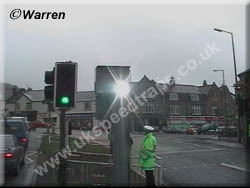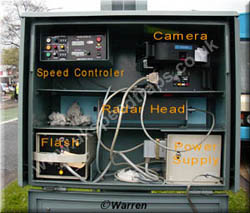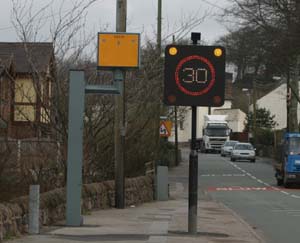Fixed Installation Post Gatso


The grey box, known as the FIP (Fixed Installation
Post), it has two windows in the front. The top one is the camera,
and the one in the bottom corner is the flash. The radar is the
darker grey rectangle in the middle. Generally infallible they
carry an 800-frame roll of film which has to be changed.
These cameras are situated at locations with a bad
accident record caused by speeding vehicles. The units use a very
sophisticated 'Doppler radar' system to measure the speed of passing
vehicles. When a vehicle exceeds a preset threshold, the device
is activated taking two photographs half a second apart. The photographs
show the date and time of the offence, together with the speed
recorded. The unit takes between three and four hundred readings
of a single vehicle as it passes through the beam. There must
not be a greater speed variation on all of these readings of more
than two miles per hour or the device will abort the test. Some
Models can also differentiate between large vehicles and cars
so a lower activation threshold can be set for large goods vehicles
and coaches.
One Web site reports that you can tell if a Gatso
is in operation by the vent holes on the back. If the holes
are open, "dark" then it's working and ready to take a picture.
If they are closed, "light" then it is not in operation. This
is untrue, these are not vents - they are, in fact, access ports
for the case locks. If they have been left open, it means that
someone has recently been fiddling with the camera and has forgotten
to secure them. So if the ports are open, it would suggest that
there is a camera in the GATSO.

Above: Don't say your weren't
warned!
However, just because the ports are closed it doesn't
mean that the GATSO has no camera or film in.
Incidentally, filling these holes with expanding
foam would not prevent the camera from working - it would merely
serve to inconvenience the operator who has to change the film.
The camera uses standard 35mm film which is on a
long reel. It is viewed in a viewer which converts the image to
a TV screen where the operator looks at the vehicle make model
and reg.no that is all the picture /operator is looking for. If
it shows the driver/passengers that is a bonus!.
It is NOT the job of the police to prove who the
driver of the vehicle was. It is the responsibility of the Registered
Keeper to tell the police that information. If you fail to do
this within a specified time period (usually 28 days) then the
Police will prosecute you for the offence of failing to give name
and address of the driver which carries up to £1000 fine and 3
points.
Your request for photographic evidence does not
stop the clock ticking for the 28 day period. If the police accept
the details that you give of another person driving, then this
other person must accept that they were the driver for you to
comply with the law under S172 of the Road Traffic Act 1988..again
if they don't the Summons comes back to you. Remember the offence
is failing to give the name and address of the driver.
Most Police forces will allow you to see the original
evidence at the place of storage (usually the Ticket Office) by
prior arrangement. This is on the special viewer. This is a concession
not a right. If you go not guilty to a summons then a copy of
the photo and other papers will be served on you prior to the
court hearing.




